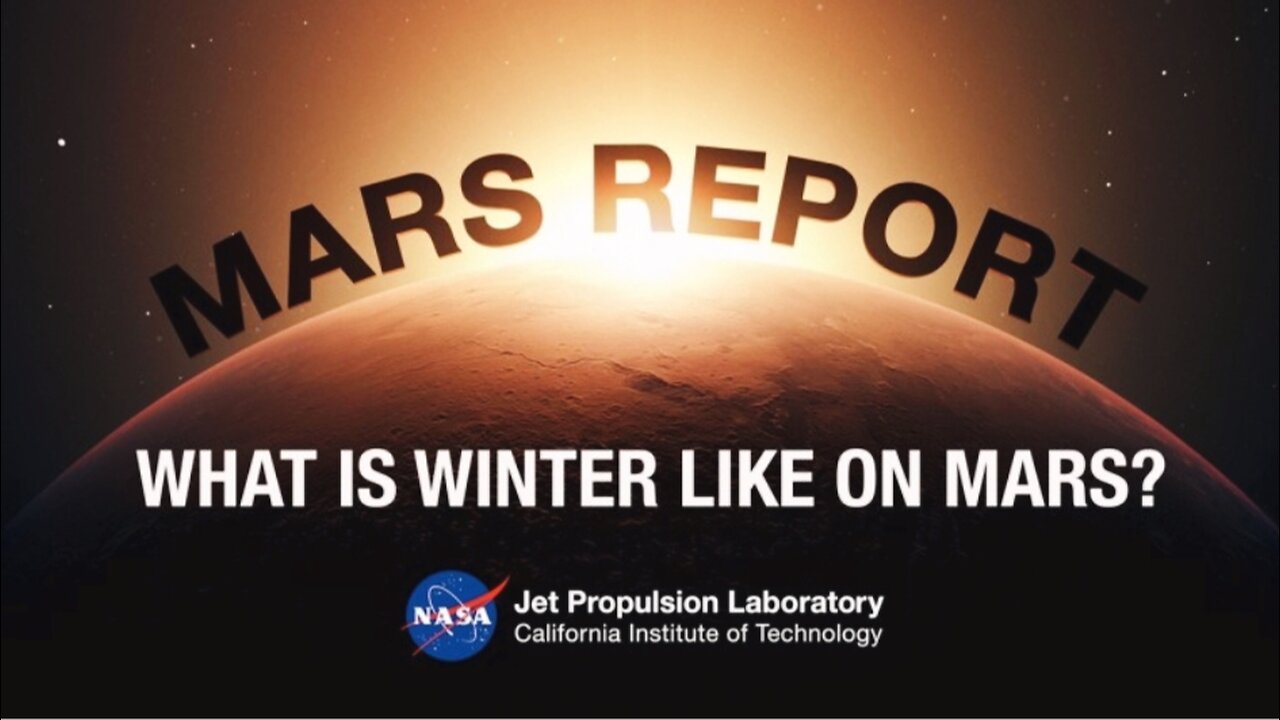Premium Only Content

Mars Report: Winter Wonderland on Mars
Mars scientist Sylvain Piqueux of NASA’s Jet Propulsion Laboratory explains how images and data collected from NASA’s Viking, Phoenix, Mars Odyssey, Mars Reconnaissance Orbiter missions can help scientists better understand the processes behind a winter on Mars. On the Red Planet, where both carbon dioxide and water can take the form of ice and frost, scientists study these frosty landscapes and unusual formations to understand the climate of Mars today and in its past. Analyzing the ice on Mars will also help future human missions.
For more information on NASA's Mars missions, visit mars.nasa.gov.
TRANSCRIPT
Sylvain Piques: This time of the year many of us are dreaming of a winter wonderland here on Earth. But did you know that Mars, our closest neighbor in the solar system, also experiences snow, ice and a real winter? Let's go check it out with our NASA spacecraft.
Marina Jurica: Let it snow takes on a whole new meaning on Mars. I'm Marina Jurica here with Silvain Piquex, and we are talking about snow, ice and frost on the red planet. Welcome, Sylvain. Now, I know it's really cold on Mars, but there's also snow and ice.
Sylvain Piques: Mars is a very dry place, but if you go to the right locations, you will find water, ice, just like the one we have on Earth, but also CO2 ice or dry ice.
Marina Jurica: Now, I know we can see frost at the poles, but can you see frost anywhere else on Mars?
Sylvain Piques: In the 1970s, the Viking landers observed water frost forming on the ground far away from the poles. So we know that the frost similar to what we have on earth, forms in those landscapes on Mars. That's cool. We also know from Mars Odyssey that we have two kinds of frost. We can observe water frost in many other locations than what Viking observed, but also CO2 frost, something that we don't have on Earth.
Sylvain Piques: It is extremely cold where you would find CO2 ice, something like -190 degrees Fahrenheit. The CO2 ice does not melt. Instead, it goes back from solid to gas directly in the atmosphere. That leads to the formation of really unique surface features. For example, we see spider shaped features, fans, geysers, Dalmatian spots, fried eggs, all kinds of unique objects that are really challenging to understand, but that are beautiful and unique to Mars.
Marina Jurica: What else have our various Mars missions taught us about the snow on the Red planet?
Sylvain Piques: A few things. First, the Phoenix Lander in this mission that arrived at Mars in 2008 observed beautiful frost landscapes that formed around it. The Phoenix Lander had a LIDAR. This is an instrument that shoots a laser up, and if there's a cloud or something that's falling down from the sky like snow, you get to return. Basically, you light up the sky and you can see when snow falls and falls.
Sylvain Piques: And it did. The Phoenix lander was also able to scratch the surface and for the first time see these water ice just below the ground. This is the kind of water ice that astronauts could potentially use in the future when we go there.
Marina Jurica: Thank you so much, Sylvia, for teaching us about the winter wonderland that's on Mars.
Sylvain Piques: My pleasure.
Marina Jurica: To get the latest updates, follow @nasajpl and @nasamars on social media, or take a deeper dive on the mission website at mars.nasa.gov.
-
 LIVE
LIVE
Wendy Bell Radio
6 hours agoUNAFRAID
12,395 watching -
 41:26
41:26
Rethinking the Dollar
52 minutes agoFriday Morning Check-In: Global Currency Clash: Trump Threatens BRICS with Severe Tariffs
-

Randi Hipper
1 hour agoBrace for Impact: XRP ETF Could Skyrocket Your Portfolio!
2.04K1 -
 44:09
44:09
BonginoReport
5 hours agoCapitol Hill Showdown: Kash Patel & Tulsi Gabbard Face Off Against DC Swamp (Ep.130) - 01/31/2025
74.7K79 -
 2:40:38
2:40:38
Matt Kohrs
11 hours agoPCE Inflation Report, Trade Wars & Payday Friday || The MK Show
19.8K1 -
 1:41:13
1:41:13
Jeff Ahern
3 hours ago $1.63 earnedFriday Freak Out with Jeff Ahern
12.7K2 -
 1:56:58
1:56:58
Game On!
11 hours ago $1.79 earnedJustin Tucker joins NFL legends in recent massage SCANDAL!
20.1K2 -
 34:12
34:12
CryptoWendyO
22 hours ago $5.97 earnedBITCOIN SUPPLY CRISIS: $7 Billion Ready To Exit The Market
52.9K14 -
 23:39
23:39
The Finance Hub
23 hours ago $25.46 earnedI CAN'T BELIEVE WHAT JUST HAPPENED TO ADAM SCHIFF!
92.6K146 -
 9:01
9:01
Dr. Nick Zyrowski
16 hours agoThe BIG NAC ( N-Acetyl Cysteine) Mistake
55.4K10